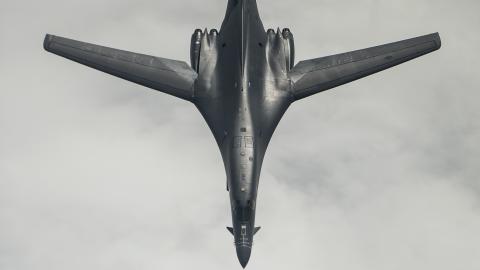Larry Korb of the Center for American Progress wants the President to adopt a defense spending base budget in the upcoming FY2024 budget which would include: (1) a lower troop end strength, (2) a smaller Navy, (3) an adjusted rate of inflation significantly less than required to avoid a pay cut for the troops, (4) a reduction in the number of F-35s the USAF acquires; and (5) an elimination of the 400 land-based ICBMs in the US Nuclear Triad.
These proposals would unfortunately make the US strategic and conventional capabilities weaker than they are today, just as North Korea, China, Iran and Russia are going in the opposite direction and markedly increasing their military capabilities. Korb apparently thinks bad guys won’t do bad things if only the US unilaterally undertakes some major virtue signaling such as a marked restraint in deploying new weapons. Korb’s new strategy must be “Peace through Surrender” as opposed to Reagan’s “Peace through Strength.”
For some very strange reason, Korb thinks national governments such as China and Russia, long animated by a communist ideology that has historically killed an estimated 120 million of their own people, will be compelled not to act badly because they are now waiting for moral direction from the United States. If only Washington wised up and just stopped building all these weapons, what an example the United States could be for the world!
Between 1997 and 2029, the United States is scheduled to deploy or put into the field ZERO new strategic long range nuclear forces such as sea launched ballistic missiles, bombers and bomber cruise missiles, submarines and land-based ICBMs. During the same period, according to Mark Schneider’s research, Russia has or will deploy some 23 new or modified nuclear strategic and regional nuclear weapons programs, including 4 types of cruise missiles, 4 types of bombers, 7 types of land based missiles, 3 types of sea launched ballistic missiles and 5 types of submarines.
Gutting the land based leg of the US Triad as Korb recommends would cut the US long range SLBM and ICBM missiles allowed under the New START treaty from 640 to 192, what the Columbia class 12 submarines can carry. And even fewer US missiles would be deployed on a day-to-day basis as our submarines are also in port, or in transit but not all are on patrol depending the tempo of operations of the boomer fleet. In addition, if the US needed to upload its forces to balance a combined Russian and Chinese nuclear deployment breakout, the US would be stuck at a maximum force of 1536 warheads on 192 fast flying SLBMs, about the number now deployed by the United States under the New START treaty of 2010.
The current plan which Korb opposes, modernizes the three legs of the Triad for the US by 2042 when the last Columbia-class submarine goes into the water. It is important to pay close attention to the time sequence of the Russian and United States deployment. Everything the US is deploying is consistent with the New START treaty of 2010. So, the deployments cannot be considered starting or completing an arms race, unless Korb and his friends think being consistent with the New START arms control treaty is actually no different than engaging in an arms race!!
The empty space for deployments for the USA has been accurately described by retired USAF General Garret Harencak as a “holiday from history” which Korb wants the US to partially duplicate now by unilaterally killing fully 57% of the strategic nuclear delivery vehicles the United States is allowed under the New START treaty.
As former Secretary of Defense Harold Brown warned us many years ago, the only thing the Russians will do in response to the US not building is for the Russians to….. keep building. How this is meant to work to reduce nuclear dangers is unclear, but unilateral disarmament has not historically succeeded in curtailing an enemies ambitions.
General Mattis was once asked whether the United States was spending too much on defense including nuclear deterrence forces. He explained the US “can afford survival.” In FY1961, at the height of the Cold War and the end of the Eisenhower administration, total Federal spending was $97 billion. Military spending since then has increased 17 fold from $50 billion to $858 billion, but all social, non-defense spending (outside of interest) by the US government has increased more than 126 fold, from $41 billion to $5.15 trillion.


















